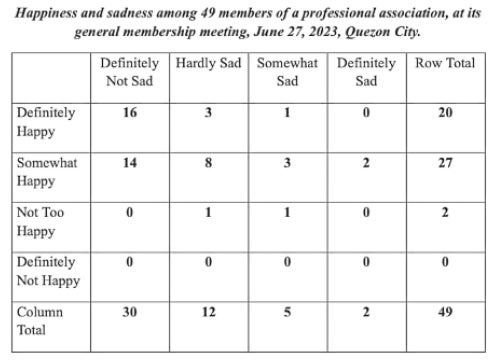My first sadness probe

On June 27, when I was guest speaker at a professional group’s general meeting on any topic I liked, I had given the title: “Happiness, Sadness, and In-Between.” With respect to happiness, there are, as a matter of fact, dozens of national surveys to draw from (see my “The happiness measurement biz,” 12/17/22). With respect to sadness, however, I know of none.
So I thought of probing, at the meeting itself, into the feelings of happiness and sadness among those present. I described to them a standard Social Weather Stations survey question on happiness: “Would you say that you are presently talagang masaya (definitely happy), medyo masaya (somewhat happy), hindi masyadong masaya (not too happy), or talagang hindi masaya (definitely not happy)?” I told them the answer choices in Filipino, not in English; they said they understood.
Then I asked them to consider the following counterpart survey item on sadness: “Would you say that you are presently talagang malungkot (definitely sad), medyo malungkot (somewhat sad), di gaanong malungkot (hardly sad), or talagang hindi malungkot (definitely not sad)?” I likewise described the item in Filipino, not English, and it was fine with them. This was the first time for me to use a survey item containing the word malungkot.
Both of the items have so-called four-point scales, with every point described in simple and understandable words. To me, they are superior to a ladder scale of numbers from 0 to 10, where only the top and bottom of the ladder are described—for instance, as the “best possible” and the “worst possible” worlds.
Each member of the 50-person group was given a small piece of paper on which to write the person’s gender, age, and answers to the two questions above. We collected 49 readable answer sheets from 11 males, 37 females, and one without a stated gender (accidentally or on purpose?). The median age was 58.
The answers are classified in the table, which I will of course share with the group. There was no show of hands as to their answers. Unless they spoke among themselves afterward, this column would be their first acquaintance with each other’s feelings about happiness and sadness.
Look at the edges of the table first; these are called the “marginals.” Out of 49 persons, the right edge shows 27 somewhat happy, the most popular answer. Then there are 20 definitely happy, two not too happy, and none definitely not happy.
The bottom edge shows that the top answer is 30 definitely not sad. It is followed by 12 hardly sad, five somewhat sad, and only two definitely sad. Note that those definitely not sad or else hardly sad are 42, or less than the 47 who are definitely or else somewhat happy.
In this 4×4 table, the diagonal cells are self-explanatory: they show 16 persons both definitely happy and definitely not sad, eight persons both somewhat happy and hardly sad, and one person not too happy and also somewhat sad. There are 25 persons on the diagonal.
The off-diagonals are very interesting, the biggest cell having 14 persons definitely not sad, but only somewhat happy. Then there are three persons hardly sad and one person somewhat sad, but all four are definitely happy. There are three persons who are both somewhat sad and somewhat happy. There are two persons definitely sad, yet somewhat happy. And one person is not too happy, yet hardly sad.
There are 24 persons off the diagonal, almost as many as on the diagonal. Naturally, happiness and sadness are inversely related. But their relation is far from simple.
Why is the elimination of poverty and hunger the top two of the 17 Sustainable Development Goals (SDGs) of the United Nations? Because lessening deprivation matters more than achieving abundance.We know from time-series data on unhappiness—the two unfavorable answers to the happiness survey question—that it is directly related to poverty and hunger. Most likely sadness, if and when it gets surveyed regularly, will prove likewise.
My personal view is that the goal most directly relevant to sadness is SDG 16: the promotion of just, peaceful, and inclusive societies. What is sadder than the killing of innocent people in the name of war on illegal drugs or on rebellion against the government?
—————-
Contact: [email protected].
Disclaimer: The comments uploaded on this site do not necessarily represent or reflect the views of management and owner of Cebudailynews. We reserve the right to exclude comments that we deem to be inconsistent with our editorial standards.

